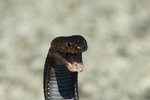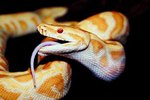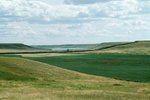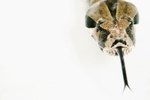
The king cobra (Ophiophagus hannah) is the lengthiest venomous snake, according to National Geographic. When king cobras raise their bodies into the air, they can match the height of a fully grown person. Despite the venom, it is not common for these carnivores to bite human beings.
King Cobra Size
King cobras usually grow to lengths of approximately 13 feet, although in extreme cases they can grow to 18 feet. King cobras generally weigh 20 pounds or less. These diurnal snakes typically possess very lean and lithe physiques.
King Cobra Skin Coloration and Texture
King cobras exist in an array of different colors, including glossy black, pale olive, gray, brownish-green, yellow and brown. Those that reside in open environments are usually paler in coloration, while those that live in dense forest settings are usually noticeably darker. At birth king cobras are pure black, with prominently barred bodies -- both in yellow and white. King cobras' throats are usually either whitish-yellow or more of a pale yellow in coloration.
Although their rough skin has a gleaming and polished look to it, it actually feels fully dry upon physical contact, rather than moist.
Other Coloration in King Cobras
These venomous snakes' underbellies usually are light yellow. The underbellies are occasionally barred as well, although some are totally solid in color. King cobra skin is often covered by bands that are either tan, yellow or white.
King Cobra "Hood"
When king cobras feel intimidated, they can create slender "hoods" by forcing their ribs, via muscle action, to surround their necks. The hood creates an illusion of larger body size -- useful for warding off potential danger. Apart from the hood, scared king cobras also often produce noisy hissing sounds -- and raise their bodies off of the ground too. The hiss has a low grumbling sound, rather than a high-pitched one. These actions generally point to an unhappy king cobra -- one that is demanding for the other party to back off, pronto. If a king cobra raises his body up without the presence of the hood, however, he probably has no intention of starting up a battle.
Venom
King cobra venom is packed with neurotoxins, which interfere with nervous system functioning by halting both respiratory functioning and heartbeat. The venom can often even bring upon life-threatening consequences. King cobras give off the venom whenever they feel defensive or frightened as a protective measure, and not necessarily in conjunction with the aforementioned hood raising. They also emit the venom to prevent their prey from moving -- so they can then enjoy a tasty meal. King cobras can inject victims both through biting and spraying the venom into the air.
References
Photo Credits
-
Tom Brakefield/Stockbyte/Getty Images




